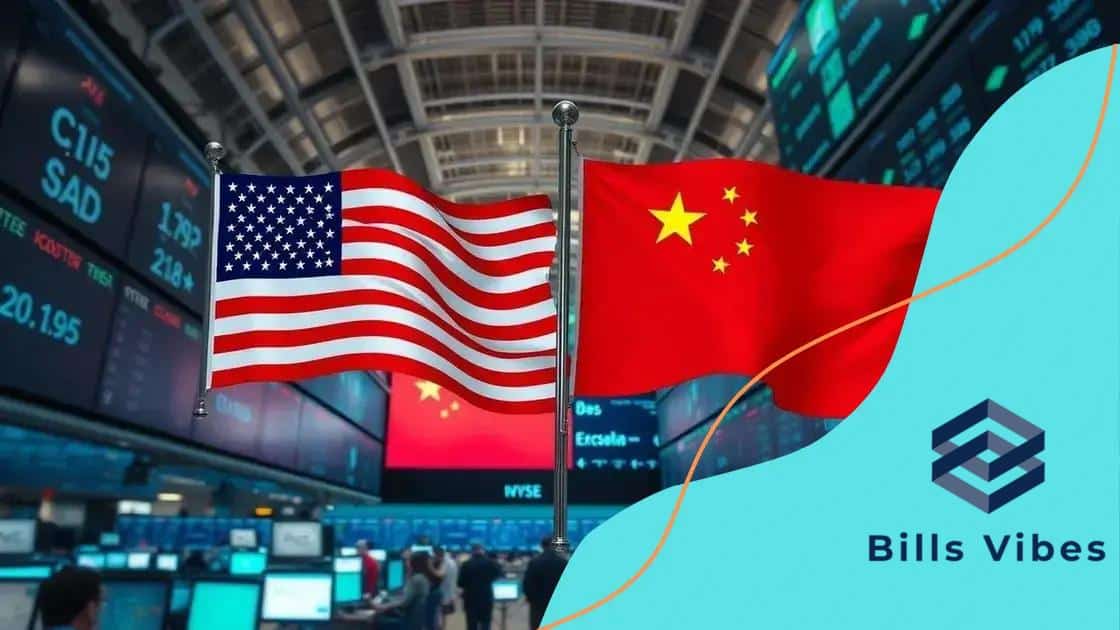US-China trade tensions grow: what you need to know

US-China trade tensions grow significantly impact global economies, driven by intellectual property concerns, trade imbalances, and geopolitical competition, leading to various possible outcomes such as cooperation or increased tariffs.
US-China trade tensions grow and are increasingly shaping the landscape of global commerce. But how do these tensions influence not just economies, but everyday consumers? Join us as we delve into the details.
Current state of US-China trade relations
The current state of US-China trade relations is complex and marked by significant challenges. Trade policies implemented by both countries have created a tense environment, impacting not just the nations involved but also the global economy. With tariffs affecting various goods, understanding the nuances of this relationship is crucial.
Tariffs and Their Effects
Tariffs are one of the main tools used in this trade war. Both the US and China have imposed tariffs on each other’s products, which has led to a considerable increase in costs for consumers and businesses alike.
- Increased prices on imported goods
- Disruption of supply chains
- Shifts in trade patterns
The implementation of these tariffs has not only affected large corporations but also small businesses and consumers. For instance, products that were once affordable are now more costly, leading to a ripple effect across various sectors.
Negotiations and Agreements
Despite ongoing tensions, there have been attempts to negotiate. High-level meetings between trade representatives have taken place, aiming to find common ground and ease economic strains. However, results have been inconsistent, with breakthroughs often followed by setbacks.
As negotiations continue, the importance of dialogue cannot be overstated. Trade relations can significantly influence international politics and economics. Understanding the US-China trade dynamic allows businesses to adapt and prepare for potential outcomes.
Key factors driving the trade tensions
Several key factors driving the trade tensions between the US and China are critical to understanding their complex relationship. These factors not only influence trade policies but also impact global economic stability.
Intellectual Property Concerns
One major issue is the concern over intellectual property rights. The US claims that China engages in unfair practices, such as stealing technology and intellectual property from American companies.
- Numerous US businesses have reported instances of IP theft.
- Technology transfers are often required for companies wanting to enter the Chinese market.
- This has led to a significant increase in tensions and mistrust between the two nations.
Addressing these concerns is essential for restoring confidence and fostering a more equitable trade environment.
Trade Imbalances
Another driving factor is the persistent trade imbalance. The US has long run a trade deficit with China, purchasing more goods than it exports. This reality has fueled discontent and demands for change.
As a result, the US has sought to reduce this deficit through tariffs and trade restrictions. These actions aim to encourage American companies to manufacture domestically rather than overseas.
The impact of trade policies often trickles down to everyday consumers, leading to increased prices on various products. Therefore, understanding these underlying factors is crucial for navigating the current economic climate.
Geopolitical Considerations
Geopolitical factors play a significant role in these trade tensions as well. Competition for global influence has intensified between the two nations. Each seeks to assert its dominance economically and politically.
This rivalry complicates negotiations and adds another layer of difficulty to resolving trade disputes. As both countries pursue their national interests, finding common ground becomes increasingly challenging.
Impact on global economies

The impact on global economies due to rising US-China trade tensions is profound and far-reaching. As these two superpowers engage in their trade disputes, countries around the world feel the effects.
Economic Ripple Effects
Many nations depend on trade with the US and China. As tariffs increase, the prices of goods rise, leading to inflation. Countries that export to either nation notice a shift in demand, which can destabilize their economies.
- Sudden hikes in import costs
- Changes in consumer behavior
- Economic slowdowns in affected countries
This interconnectedness emphasizes how dependent global economies are on US-China relations. Tensions can disrupt financial markets, causing uncertainty and volatility.
Impact on Developing Countries
Developing countries are often at a greater disadvantage during these times. As trade priorities shift, they sometimes lose out on valuable trade agreements. For instance, nations trying to compete for market share can find it increasingly difficult.
This can lead to greater economic inequality, with larger economies benefiting while smaller ones struggle to keep up. Moreover, these countries may find themselves caught in the crossfire of the trade war, facing higher tariffs on their exports.
Corporate Strategy Adjustments
Businesses worldwide are reassessing their strategies to adapt. Many companies reconsider their supply chains, looking for ways to minimize costs and avoid tariffs. This means relocating production facilities to countries less affected by the trade tensions.
Such adjustments can lead to job losses in certain regions and create new opportunities elsewhere. Ultimately, companies focused on resilience and adaptation may find new avenues for growth amidst the disruption.
Negotiation strategies and outcomes
Effective negotiation strategies are essential when dealing with the ongoing trade tensions between the US and China. Both countries have implemented various tactics to navigate these challenging times. Understanding these strategies can provide insights into potential outcomes.
Key Negotiation Tactics
Both sides utilize specific tactics during negotiations. For example, they often use public statements to influence perceptions and pressure the other side. This can create a sense of urgency or frustration.
- Leveraging tariffs as bargaining chips
- Engaging in back-channel communications for informal discussions
- Setting deadlines to compel action
These tactics can change the dynamics of negotiations. They reflect the strategic interests of each country and the desire to maintain or regain economic influence.
Outcome Scenarios
Various outcomes could arise from negotiations between the US and China. One scenario might include a comprehensive trade agreement, addressing key issues such as tariffs and intellectual property protection. This could lead to a stabilization of trade relations.
Alternatively, tensions might escalate, resulting in further tariffs and restrictions. This would only deepen the divide and pose challenges for global economies. Each outcome carries significant implications for businesses and consumers worldwide.
Long-term Implications
The strategies used during negotiations can have long-term effects. For instance, a successful agreement could pave the way for increased cooperation and economic collaboration between the two nations.
On the other hand, prolonged disputes can lead to relocation of industries and supply chains, altering the landscape of global trade. Understanding these potential consequences is vital as they shape future economic policies.
Future projections for trade relations
The future projections for trade relations between the US and China are uncertain, but trends suggest a mixed landscape. Analysts predict several potential scenarios, which could either ease tensions or exacerbate them further.
Potential for Cooperation
Some experts believe that both nations will eventually seek cooperation. This could be driven by the need for economic stability in light of global challenges, like pandemics and climate change. If both sides find common interests, they may work towards a more balanced trade agreement.
- Increased dialogue between leaders
- Collaborative efforts on global issues
- Reduced tariffs and trade barriers
Such cooperation could lead to a more stable economic environment, benefiting businesses and consumers alike.
Escalation of Tensions
On the other hand, ongoing disputes may lead to further escalations. If both sides stick to their positions, we could see stricter tariffs and even increased sanctions. This would likely disturb global supply chains and affect economies worldwide.
Businesses may face higher costs, leading to price increases for consumers. The ramifications of these tensions could lead many countries to reassess their trade strategies.
Shifts in Global Trade Alliances
The trade landscape may also see significant shifts as countries realign themselves based on the US-China trade war. Nations could seek new partnerships or strengthen existing ones to create a buffer against the repercussions of ongoing tensions.
For instance, countries in Southeast Asia might gain more influence as businesses look for alternatives to China. These shifts could redefine global trade relationships and alter economic power dynamics.
FAQ – Questions about US-China Trade Relations
What are the main factors driving US-China trade tensions?
The main factors include intellectual property concerns, trade imbalances, and geopolitical competition.
How do trade tensions affect global economies?
Trade tensions can lead to increased prices, disrupted supply chains, and shifts in trade patterns, impacting economies worldwide.
What are potential future outcomes of US-China negotiations?
Future outcomes could range from cooperation and trade agreements to escalations in tariffs and further restrictions.
How should businesses adapt to the changing trade landscape?
Businesses should reassess their supply chains and stay informed about changes in trade policies to mitigate risks and seize new opportunities.






